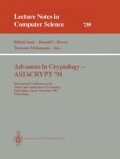Abstract
We present various ways of speeding up the standard methods for generating provable, resp. probable primes. For probable primes, the effect of using test division and 2 as a fixed base for the Rabin test is analysed, showing that a speedup of almost 50% can be achieved with the same confidence level, compared to the standard method. For Maurer's algorithm generating provable primes p, we show that a small extension of the algorithm will mean that only one prime factor of p−1 has to be generated, implying a gain in efficiency. Further savings can be obtained by combining with the Rabin test. Finally, we show how to combine the algorithms of Maurer and Gordon to make ”strong provable primes” that satisfy additional security constraints.
Preview
Unable to display preview. Download preview PDF.
References
L.Adleman and M.-D.Huang: Recognizing Primes in Random Polynomial Time, Proc. of STOC 1987, 462–469.
E.Bach and J.Shallit: Factoring with Cyclotomic Polynomials, Math. Comp. (1989), 52: 201–219.
P.Beauchemin, G.Brassard,C.Crépeau, C.Goutier and C.Pomerance: The Generation of Numbers that are Probably Prime, J.Cryptology (1988) 1:53–64.
J.Brillhart, D.H.Lehmer and J.L.Selfridge: New Primality Criteria and Factorizations of 2m±1, Math. Comp. (1975), 29: 620–647.
Damgård and Landrock: Improved Bounds for the Rabin Primality Test, to appear.
P.Erdös and C.Pomerance: On the Number of False Witnesses for a Composite Number, Math. Comp. (1986), 46: 259–279.
J.Gordon: Strong Primes are Easy to find, Proc. of Crypto 84.
R.K. Guy: How to Factor a Number, Proc. of the 5'th Manitoba Conference on Numerical Mathematics, 1975, University of Manitoba, Winnipeg.
S.H. Kim and C. Pomerance: The Probability that a Randomly Probable Prime is Composite, Math. Comp. (1989), 53: 721–741.
U.Maurer: The Generation of Secure RSA Products With Almost Maximal Diversity, Proc. of EuroCrypt 89 (to appear).
C.Pomerance: On the Distribution of Pseudoprimes, Math. Comp. (1981), 37: 587–593.
M.O. Rabin: Probabilistic Algorithm for Testing Primality, J.Number Theory (1980), 12: 128–138.
Author information
Authors and Affiliations
Editor information
Rights and permissions
Copyright information
© 1993 Springer-Verlag Berlin Heidelberg
About this paper
Cite this paper
Brandt, J., Damgård, I., Landrock, P. (1993). Speeding up prime number generation. In: Imai, H., Rivest, R.L., Matsumoto, T. (eds) Advances in Cryptology — ASIACRYPT '91. ASIACRYPT 1991. Lecture Notes in Computer Science, vol 739. Springer, Berlin, Heidelberg. https://doi.org/10.1007/3-540-57332-1_37
Download citation
DOI: https://doi.org/10.1007/3-540-57332-1_37
Published:
Publisher Name: Springer, Berlin, Heidelberg
Print ISBN: 978-3-540-57332-6
Online ISBN: 978-3-540-48066-2
eBook Packages: Springer Book Archive

